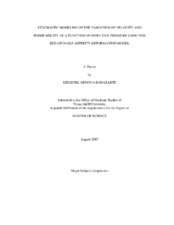| dc.description.abstract | The mechanical and transport properties of porous and cracked media, such as
velocity and permeability, are sensitive to the effects of effective pressure, which itself is
a function of the confining pressure and the pore-fluid pressure. The dependence of
permeability and velocity on effective pressure has previously been modeled using the
Bed-of-Nails asperity-deformation model. The main objective of this research was to
explore the sensitivity of the Bed-of-Nails and effective-pressure models to random,
Gaussian errors, by using an inverse approach. To achieve this, numerical modeling of
pre-existing velocity and permeability experimental data sets was done.
Extrapolation to 600 MPa was performed using an epidosite data set of
compressional velocity as a function of confining pressure, only using measurements in
the range 0-100 MPa. The results showed that, given sufficient data and considering
random error only, extrapolation can be done with a level of error of less than 1.5%.
Model error can also be significant in this type of exercise because it can give rise to
systematic misfit, although in this case it was shown that the effects of model error were
not considerable. Modeling the variation of compressional velocities as a function of confining and pore-fluid pressures in a deep-sea chalk showed that the best-fitting
asperity-deformation model is sensitive to the effective-pressure model.
Measurements of permeability in a Navajo-sandstone specimen as a function of
confining pressure were numerically modeled, and the results showed that measurements
made at low pressures, specifically near Pe = 0, are very important to constrain the
model. The same result was found in the case of permeability as a function of confining
and pore-fluid pressure in a Wilcox-shale where the lack of measurements near Pe = 0
caused the error in the model parameters to be overestimated. This occurs because the
rate of change of permeability as a function of effective pressure is very high at low
pressures. The lack of sufficient data near Pe = 0 overestimates the curvature matrix and,
therefore, the errors in the model parameters. | en |


